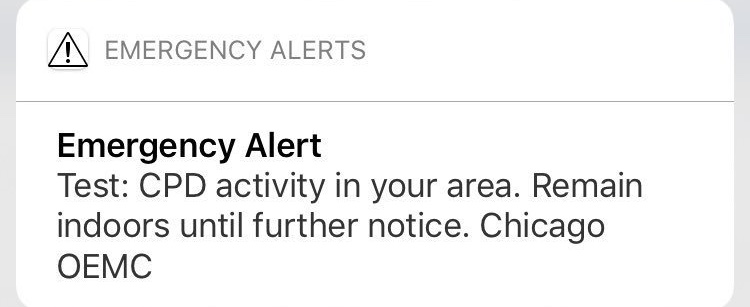Chicagoans Alarmed by ‘Extreme Alert’ Message

July 22, 2019 Some Chicago residents were frightened on Monday after receiving a “extreme alert” text message from city’s Office of Emergency Management. Only residents that signed up for the city’s Notify Chicago program received the alerts, which it turns out was only a test.
Block Club Chicago reports some Chicago residents received the following “extreme alert” text on their mobile phones around 3:40 p.m., warning them to take cover, but Chicago police say it was only a test.
“Extreme Alert: Test: CPD activity in your area. Remain indoors until further notice. Chicago OEMC.”
Other alerts, possibly depending on cell phone carrier just said “emergency” instead of “extreme.”
NOTIFY CHICAGO
Chicago’s Office of Emergency Management’s Notify Chicago program debuted in September, 2018. Notify Chicago provides residents with text messages, and/or e-mail alerts on various emergency and non-emergency situations taking place throughout Chicago. OEMC urges residents to subscribe via Smart911.com website and create a safety profile for their family, including critical medical information they want 9-1-1 and first responders to have in the event a 911 call is placed from the associated phone number.
Last week, Chicago police scrambled to a Loop office after a 9-1-1 call about an active shooter, but it ended up being a drill that employees apparently were not told about. Chicago Police First District Cmdr. Michael Pigott called the situation an “active shooter drill that went terribly wrong,” saying that a “proper notification was not made.”
In the weeks after the September 11, 2001 terrorist attack on American soil, cities across the country scrambled to update emergency plans which up to that point were merely symbolic plans on paper.
The U.S. Department of Homeland Security was created in the aftermath of 9/11 with the purpose of protecting the homeland from future attacks. DHS distributes grants to state, local, tribal, and territorial jurisdictions that can be used for training, exercises, planning, personnel, and equipment to better prepare for disasters — whether natural or man made.
Many excellent drills and exercise programs were created and implemented as a result of the homeland security grant programs. However, the programs are costly to maintain and when cities face budget woes, drills are often the first programs cut.
Other than actual events, exercises and drills are the only way the measure a city’s preparedness level—or as last week’s drill gone “terribly wrong” evidenced lack there of.